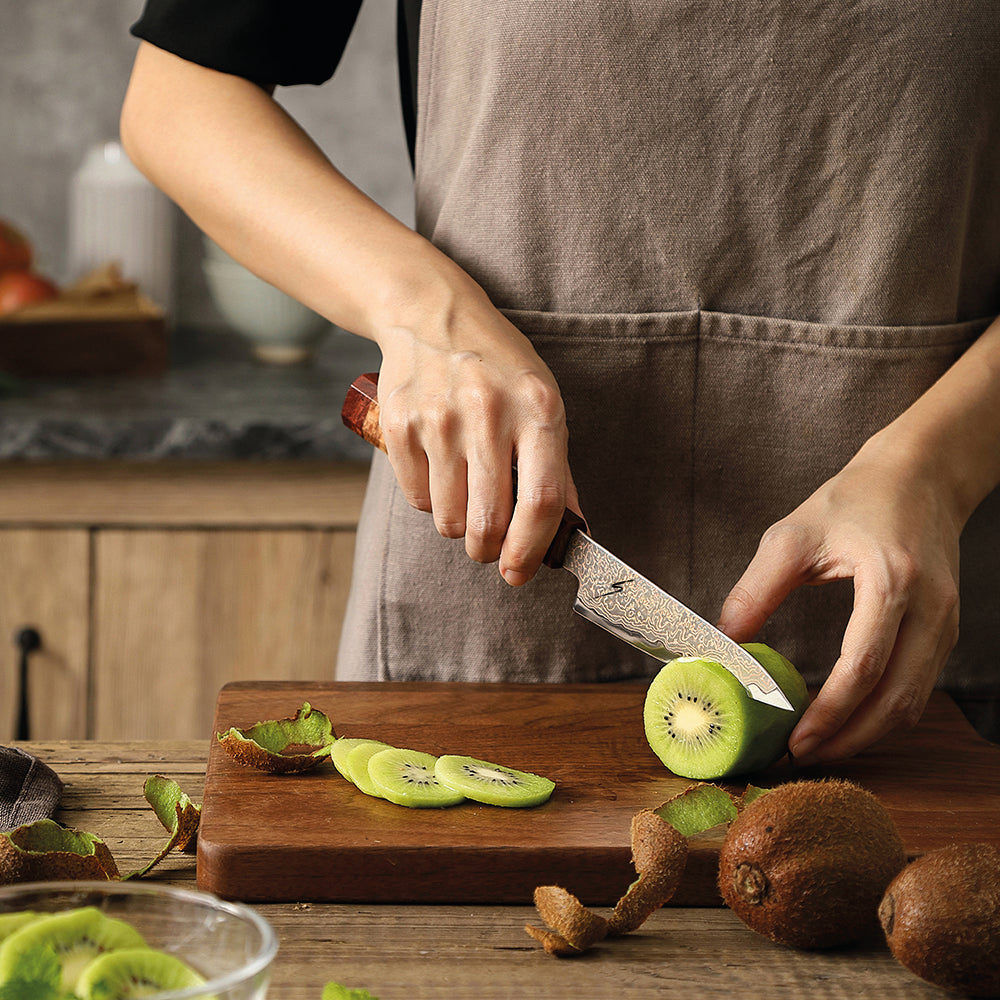
Tips & Advice on Selecting the Right Kansai Knife
Step 1: Identify Your Needs
Ask yourself these questions:
-
What do you cook most often? (meats, vegetables, bread, fish, etc.)
-
Do you prefer a light, agile knife or a heavier, more robust one?
-
Do you value easy maintenance, or are you comfortable with a little more care for premium performance?
-
What’s your skill level — beginner, intermediate, or professional?
Your answers will help you narrow down the style and steel that’s right for you.
Knife Types in the Kansai Range and What They’re Best For
The Essential All-Rounders
Gyuto (Chef’s Knife)
The most versatile blade in the kitchen. Great for slicing, chopping, dicing vegetables, meats, and herbs.
Best for: Everyone — from beginner home cooks to professionals.
Recommended series: RYUJIN VG10 for professionals, FUDO Sandvik for value-conscious home cooks.
Santoku (Multipurpose Knife)
A Japanese all-rounder that excels in push cuts and precise slicing. Lighter and more compact than a gyuto.
Best for: Smaller kitchens, cooks who prefer a nimble, balanced knife.
Recommended series: KOTSU VG10, KIYOSHI VG10.
Specialty Knives
Nakiri (Vegetable Knife)
Thin, rectangular blade perfect for chopping vegetables with precision.
Best for: Vegetarian and vegetable-heavy diets.
Recommended series: ZENITH VG10, KAZE VG10.
Cleaver / Chopper
Heavy and robust for breaking through bones and tough cuts.
Best for: Butchers, heavy meat preparation.
Recommended series: KAZE VG10, RYUJIN VG10.
Bunka
A bold, angular blade combining the utility of a santoku with a more aggressive tip for intricate work.
Best for: Adventurous home cooks and professionals.
Recommended series: IKIRU VG10, ZENITH VG10.
Paring Knife
Small and precise, perfect for peeling, trimming, and delicate work.
Best for: Every kitchen needs one.
Recommended series: Any series — KIYOSHI VG10 or FUDO Sandvik for beginners.
Bread Knife
Serrated blade for cutting through crusty bread without crushing it.
Best for: Bakers and bread lovers.
Recommended series: All series include a bread knife.
Step 2: Choose Your Steel
Kansai knives are made with premium steels, each with its own feel and care needs.
VG10 Steel (Most Popular)
-
Razor-sharp edge, great corrosion resistance, excellent durability
-
Ideal for professionals and serious home cooks
-
Found in series: KOTSU, KAZE, RYUJIN, KIYOSHI, ZENITH, HOKUTO
-
Maintenance: Hand wash and dry after use
SRS13 Steel (Ultra-Premium)
-
Exceptional hardness, edge retention, and toughness
-
Found in the Takumi series — recommended for those who want top-tier performance
-
Maintenance: Same as VG10, but worth the extra care
Sandvik Steel (Affordable and Reliable)
-
Tough and easy to maintain
-
Found in the FUDO series — excellent value for beginners
-
Maintenance: Very forgiving
AUS-8 Steel (Light and Refined)
-
Combines sharpness, easy maintenance, and affordability
-
Found in the Yamato series — ideal for everyday use
Step 3: Pick Your Handle
We offer a range of handle materials, each providing a different look and feel.
-
Olive Wood (Yamato Series): Elegant and warm in the hand
-
Sycamore and Padauk Burl (Shinrai): Unique, luxurious patterning
-
Desert Ironwood (Takumi): Durable and visually stunning
-
Pakka Wood (Azuma Series): Tough and moisture-resistant
-
Classic Wood Block Sets (Kaze, Kotsu, RYUJIN): Beautiful and practical for display and storage
Step 4: Care and Maintenance
Even the finest knife needs care. Follow these guidelines to keep your Kansai knife performing at its best:
-
Always hand wash and dry immediately — never use a dishwasher
-
Use a wooden or plastic cutting board to protect the edge
-
Hone your knife regularly; sharpen as needed
-
Store in a knife block or on a magnetic strip to avoid dulling
Who Is Each Kansai Series For?
| Series | Best For |
|---|---|
|
FUDO (Sandvik) |
Beginners, budget-conscious, daily cooking |
| YAMATO (AUS-8) | Everyday cooks who value elegance and lightness |
| KIYOSHI (VG10) | Balanced performance and aesthetics |
| KAZE (VG10) | Broad range, serious home cooks |
| KOTSU (VG10) | Compact and versatile sets |
| RYUJIN (VG10) | Professionals, chefs, high durability |
| ZENITH (VG10) | Advanced home cooks and professionals |
| IKIRU (VG10) | Large sets, collectors, creative chefs |
| TAKUMI (SRS13) | The ultimate choice for elite performance |
| SHINRAI (AISI 440A) | Artful, specialty bunka knife |
Final Tips
-
If you’re unsure, start with a gyuto — it’s the most versatile blade
-
Add specialty knives (nakiri, bunka, bread, cleaver) based on what you cook most
-
Invest in a good block set if you want an instant upgrade to your kitchen
-
Take pride in caring for your knife — it’s a lifelong tool
Need More Help?
Contact our team anytime — we’re happy to recommend the right knife or set for your needs.
Email us at [your email] or chat with us live.
